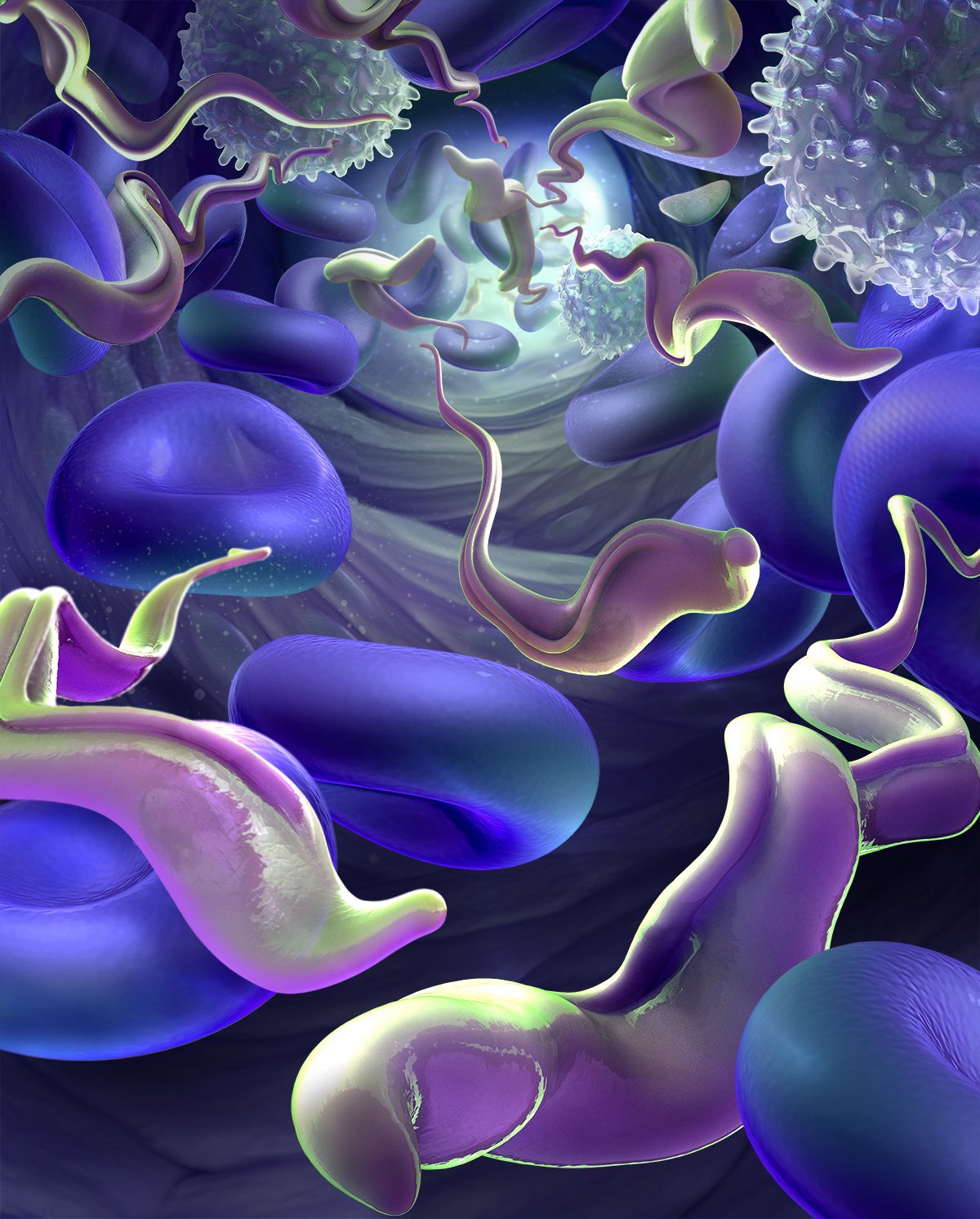

A VAST Amount of Potential
We have developed a unique vaccine and antibody generation platform by harnessing the coat of the African trypanosome. This highly unusual surface is densely carpeted by ~10 million copies of a single protein, the Variant Surface Glycoprotein (VSG), and is unique in the microbial world. The VAST system (VSG-immunogen Array by Sortase Tagging) is built on more than a decade of research into exploiting this highly immunogenic coat for vaccination purposes. The science behind the platform has been presented in numerous peer reviewed publications (e.g., Journal of Immunological Methods 2010, Nature Communications 2017, Cell Reports 2023). Early stage work was funded by a prestigious NIH Transformative Research Award. Recently the platform was supported by an NIH SBIR award to sublicensee Hepione Therapeutics Inc. (for applications in anti-opioid treatments) as well an a European Research Council Proof of Concept award.
15 years ago, the idea for the VAST platform was born in the laboratory of Dr. Papavasiliou and developed across two continents.
How It Works
Identify target antigen
Determine a research, diagnostic, or disease target for antibody or vaccine approaches. Carbohydrates, lipids, proteins and peptides, even small molecules are amenable to our VAST technology.
Coat surface with antigen
Antigens of interest are covalently attached to individual VSG proteins of the densely patterned surface.
Produce monoclonal antibodies and vaccines
The antigen-coated surface is finished into the VAST product that is ready for animal or human inoculation, either for the purposes of vaccination to develop immunity or for the production of monoclonal antibodies for numerous purposes.

VAST Details
Panosome’s technology is focused in the area of monoclonal antibodies (mABs). Our VAST technology develops antibody drugs that bind disease targets that are traditionally challenging for mAB technologies.
In medicine, antibodies are generated by a 3-step process:
(1) Generation of an immunogen of target of interest
(2) Immunization to elicit an antibody response
(3) Screening of thousands of antibodies in a cumbersome process to find those with high affinity to their target
Panosome’s VAST technology drastically improves antibody elicitation and selection:
(1) An innovative and extremely powerful immunization platform (the VAST)
(2) Adapted immunization processes
(3) A highly efficient digital antibody drug selection process (VAST Hyper Speed, see below)
The Trypanosome Coat
Trypanosomes are parasites living in the blood where they are constantly in direct contact with the immune system. The trypanosome surface is densely carpeted with 10 million copies of a single highly immunogenic protein: the Variant Surface Glycoprotein (VSG). The VSG-covered trypanosome surface is highly immunogenic as it quickly elicits extremely powerful antibodies against a specific VSG that kill all trypanosomes with that respective VSG.
Counterintuitively, Trypanosomes benefit from eliciting specific antibodies. This is due to their unique survival strategy of antigenic variation. While every trypanosome has 2000+ VSG variants encoded in its genome, every individual cell expresses only one VSG variant at a time. Upon infection with some trypanosomes of one VSG variant (denoted green in figure), the green trypanosomes multiply. A highly specific antibody response against the green VSG is elicited and kills all trypanosomes with the green VSG variant. Some trypanosomes switch off expression of the green VSG and switch on expression of the "blue" VSG variant that is not detected by the green-specific antibodies, rendering them ineffective and ensuring the trypanosome’s survival. During infection, this process repeats continuously. The highly-specific antibodies elicited to each VSG insures that switching to a new VSG will make those antibodies useless.
VAST redirects anti-VSG immune responses to molecules of choice
Over a decade ago, we investigated whether we could derivatize the VSG arrays that make up the surface layer of the African Trypanosome with molecules of interest in order to exploit the exceptional antigenicity of this coat. Initially, we genetically engineered VSGs to incorporate short peptides (e.g. FLAG) into solvent-exposed loops of the proteins with great success. To extend the system's applicability to other types of antigens, we then engineered VSGs to serve as substrates for the transpeptidation reaction catalyzed by the bacterial enzyme sortase (known as "sortagging").
By genetically engineering “sortagable” VSGs and chemically synthesizing sortagable antigens of interest, we have transformed the surface envelope of the African trypanosome into a molecular display platform. This allows us to display a very wide range of antigens against which antibodies can be produced. We have named this platform the VAST (VSG-immunogen Array by Sortase Tagging).
VAST Hyper Speed process allows fast digital selection of superior antibodies
In conjunction with the VAST, we have also developed a novel bioinformatic pipeline to streamline and accelerate the discovery of high-affinity antibodies, that we call Hyper Speed. The key breakthrough is the coupling of two techniques in a novel manner. The first is single, B-cell sorting of antigen-baited antibodies from immunization. The second is analyzing the entire transcriptome (expressed genes) of these cells and developing a set of markers to classify which are memory B-cells expressing the most potent antibodies. Coupled together, these elements allow us to identify powerful antibody sequences from a few memory cells rather than testing thousands of clones as is often required to find good candidate therapies.
Results
Initial proof-of-concept work - anti-fentanyl antibodies to combat opioid overdose - shows how well this process works. Using the VAST to generate an immune response followed by Hyper Speed, ten candidate antibodies were selected from thousands. All ten showed pico-molar affinity, with more than half in the low pico-molar range. These antibodies protected animals from fentanyl toxicity when administered as monoclonal antibody therapy. VAST + Hyper Speed therefore allowed the examination of only ten antibodies from the entire B-cell repertoire from immunization, and all ten showed therapeutic levels of binding activity.










